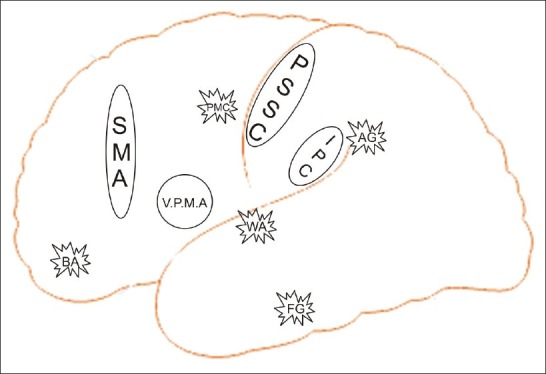Perception and Action
134 Mirror Neurons
Learning Objectives
Know that mirror neurons are located in the premotor cortex (frontal lobe).
Be able to explain the function of mirror neurons.
Mirror neurons represent a distinctive class of neurons that discharge both when an individual executes a motor act and when they observe another individual performing the same or a similar motor act. These neurons were first discovered in monkeys’ brains. In humans, brain activity consistent with that of mirror neurons has been found in the premotor cortex, the supplementary motor area, the primary somatosensory cortex, and the inferior parietal cortex.

What might be the functional role of the mirror neuron system? Hypotheses such as action understanding, imitation, intention understanding, and empathy have been put forward to explain the mirror neurons’ functional role. In addition to these, it has also been suggested that the mirror neuron system represents the basic neural mechanism from which language evolved.
How might mirror neurons be connected with empathy and emotion? One of the fundamental arguments surrounding the discovery of mirror neurons lies in the fact that these neurons help understand the motor acts of others in an immediate way, without being mediated by a reflexive-conceptual process. This type of understanding of intentionality is obtained based on the acts perceived in others through motor resonance in the perceiver, which in turn enables the understanding of motor intentions as emotional states. Thus, the understanding of perceived motor acts arises first at the motor and emotional level rather than at the reflexive and conceptual level. More details about the connection between mirror neurons and emotions/empathy can be found in the RACC article (Brunsteins, 2011).
However, the question of what the function is of the mirror neuron system is probably an ill-posed question. Mirror neurons do not have a unique functional role. Their properties indicate, rather, that they represent a mechanism that maps the pictorial description of actions carried out in the higher order visual areas onto their motor counterpart. This matching mechanism may underlie a variety of functions. More details about specific functions served by mirror neurons are in this Scholarpedia article.
Learn more about mirror neurons in the video linked here and included below.
Acharya, S., & Shukla, S. (2012). Mirror neurons: Enigma of the metaphysical modular brain. Journal of natural science, biology, and medicine, 3(2), 118–124. https://doi.org/10.4103/0976-9668.101878
Giacomo Rizzolatti and Maddalena Fabbri Destro (2008) Mirror neurons. Scholarpedia, 3(1):2055.
Antonio Damasio (2011), Scholarpedia, 6(3):1804.
Brunsteins, P. (2011). El Rol de la Empatía en la Atribución Mental [The Role of Empathy in Mental Attribution]. Revista Argentina de Ciencias Del Comportamiento, 3(1), 75–84.
Mark Aronoff (2007), Scholarpedia, 2(5):3175.

